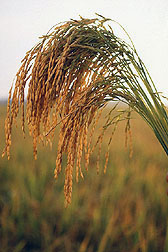This page has been archived and is being provided for reference purposes only. The page is no longer being updated, and therefore, links on the page may be invalid.
Renamed Laboratory Helps California Rice GrowersBy Kathryn Barry StelljesJanuary 21, 2000 California rice growers can reduce threats to their crop yield from excess salinity thanks to guidelines developed by scientists with the Agricultural Research Service and the University of California Cooperative Extension Service. Researchers at ARS' George E. Brown, Jr., Salinity Laboratory in Riverside, Calif. contributed to studies showing that rice yields were more sensitive than previously thought to salinity levels. The laboratory has operated in Riverside for more than 60 years, the last 5 years in a new facility on the University of California campus. The Salinity Laboratory is being renamed by the U.S. Department of Agriculture for the late Congressman Brown in a ceremony today at the lab. ARS is the USDA's chief research agency. In California, rice is grown in fields with water flooded throughout a series of adjacent basins. California ranks third in U.S. rice production behind Arkansas and Louisiana. In 1999, more than one-half million acres were harvested. State regulations require that water be held in these basins for a certain period of time to allow pesticides used by rice farmers to degrade before the water is released into local waterways. In drought years, if the water is held too long, evaporation can concentrate salts to a level detrimental to plant growth. International guidelines developed in the 1960s use an electrical conductivity value of almost 2,000 milligrams of salt per liter of water as the threshold for salinity concerns. But for rice growers under California climate and cropping conditions, researchers showed that yield losses started to occur when levels got to about 1,300 milligrams of salt per liter of water. At certain growth stages, damage resulted from even lower salinity levels. Using guidelines developed with the researchers, regulatory agencies approved procedures for allowing emergency releases of the water if salinity levels increased to dangerous levels during the 1998 to 2000 growing seasons. Thanks to sufficient rainfall, very few emergency releases were needed during the past two years. The guidelines remain in effect for the upcoming growing season. Scientific contact: Michael Shannon, ARS George E. Brown, Jr., Salinity Laboratory, Riverside, Calif., phone (909) 369-4814, fax (909) 369-4960, MSHANNON@ussl.ars.usda.gov. A news release on the renaming ceremony is available from Linda McElreath of ARS Information Staff, phone (301) 504-1658, fax (301) 504-1641 |

